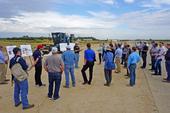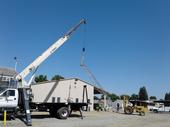- Author: Jeannette E. Warnert

A torrent of technology is flowing into the agricultural sector. To make sense of it, UC Agriculture and Natural Resources, Fresno State and West Hills Community College came together with technology vendors and growers at Open Farm 2018, held in October at UC ANR's Kearney Agricultural Research and Extension Center in Parlier.
“A lot of technology is coming out,” said Kearney director and UC Cooperative Extension agronomy specialist Jeff Dahlberg. “I need to caution you, it's not all is based on science. We are helping with testing.”
- Author: Jeannette E. Warnert

The dizzying impact of the digital revolution on many sectors of society – from retail to law enforcement, politics and entertainment – has also altered the picture on California farms.
With technology, farmers have found ways to reduce pesticide use, increase irrigation efficiency, reduce travel into the fields, manage people better, and deal with labor shortages. Much more can be done.
To connect farmers interested in ag innovations with researchers who can confirm the potential of new technologies, UC Agriculture and Natural Resources created Verde Innovation Network for Entrepreneurship, or the VINE. The program has launched a website at



